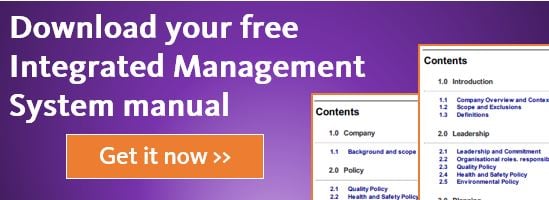Building a relationship with your interested parties is another “no-brainer” but nevertheless companies seriously overlook this as a strategy.
Your interested parties - suppliers, contractors, partners, customers, investors, employees or society as a whole - can significantly influence the performance of your business.
Ignoring the management of these relationships is a serious and common quality management error. Poor relationships with your interested parties can significantly harm your profits – this can happen through increased costs, or by a reduction in revenue. Your top and bottom lines are at risk here.
When I was a Senior Auditor for a Certification Body and auditing companies for ISO 9001 or ISO 14001, supplier management especially was always an area that companies were very weak in. I have blogged about this previously: “Too few organisations make supplier management a priority, but the ones that do reap impressive rewards”. I still stand by that statement.
It’s true that relationship management takes time. It takes money. It takes effort. But people typically like to take the shortest path between two points, so for many the easiest way to “do” relationship management is to…not do it.
Many compliance professionals instead decide that it’s more important to make their documents look pretty, their priority for the day being to get the conditional formatting right on their spread-sheets.
Excelling in Relationship Management
Actively managing your relationships is a great idea that will pay off. If you even do just that minimum amount, you will be streets ahead of most other organisations.
But…if you want go further than the basics and really excel in relationship management (and why wouldn’t you?), there are a couple of things you can do.
Step back from the problem
First, when there’s a problem, rather than diving headfirst into blame and shame, instead take a moment to step back. Bring the customer into focus. How does the issue affect them? What do you all stand to lose if the customer’s needs aren’t met?
It’s very easy to forget that you and your interested parties all want the same thing, namely, a delighted customer. Keeping the customer in the focus will enable you to solve the problem together.
Pointing the finger at each other – effectively leaving the customer forgotten in the margins – moves you exactly nowhere. Changing an adversarial customer-supplier relationship into a mutually beneficial partnership will improve quality, reduce costs, and increase market share for both parties.
Focus on Trust
I always come back to what Deming says about suppliers. This is his point 4 of his 14 points for management: “End the practice of awarding business on the basis of price tag. Instead, minimize total cost. Move toward a single supplier for any one item, on a long-term relationship of loyalty and trust”.
Relationships are never a one-way street. It’s so easy to blame the other party for any issues that arise. It is much harder – and obviously, much smarter - to work with them to prevent the issue from happening in the first place. Trust can be a long-term game changer.
Bama and McDonalds
This isn’t just a fine theory. Take the example of the company Bama, apple pie supplier to McDonalds. The two companies have been working together since 1957, with Bama currently earning $250 million dollars annually in sales from their relationship with the fast-food restaurant.
In all of that time Bama has never had a written contract with McDonalds. As Paula Marshall, CEO of Bama says: “McDonald’s in the only one that today, still, does not put any stock in a contract. They put stock in relationships”. You should consider doing the same.
Takeaway
Dr. Kaoru Ishikawa, a key figure in the development of quality initiatives in Japan, has suggested 10 principles to ensure quality products and services and eliminate unsatisfactory conditions between the customer and the supplier. Ignore these at your peril:
- Both the customer and the supplier are fully responsible for the control of quality
- Both the customer and supplier should be independent of each other and respect each other’s independence.
- The customer is responsible for providing the supplier with clear sufficient requirements so that supplier can know precisely what to produce.
- Both the customer and the supplier should enter into a non-adversarial contract with respect to quality, quantity, price, delivery method, and terms of payments.
- The supplier is responsible for providing the quality that will satisfy the customer and submitting necessary data upon customer’s request.
- Both the customer and the supplier should decide on the method to evaluate the quality of the product or service to the satisfaction of both parties.
- Both the customer and the supplier should establish in the contract the method by which they can reach an amicable settlement of any disputes that may arise.
- Both the customer and the supplier should continually exchange information, sometimes using multifunctional teams, in order to improve the product or service quality.
- Both the customer and the supplier should perform business activities such as procurement, production, and inventory planning, clerical work, and systems so that an amicable and satisfactory relationship is maintained.
- When dealing with business transactions, both the customer and supplier should always have the best interest of the end user in mind.
View previous blogs in this series "How to Implement a QMS and Achieve ISO 9001 Certification":
How to Implement a QMS and Achieve ISO 9001 Certification - Part 1: Introduction
How to Implement a QMS and Achieve ISO 9001 Certification - Part 2: Customer Focus
How to Implement a QMS and Achieve ISO 9001 Certification - Part 3: Leadership
How to Implement a QMS and Achieve ISO 9001 Certification - Part 4: Engagement of People
How to Implement a QMS and Achieve ISO 9001 Certification - Part 5: Process Approach
How to Implement a QMS and Achieve ISO 9001 Certification - Part 6: Improvement
How to Implement a QMS and Achieve ISO 9001 Certification - Part 7: Evidence Based Decision Making
.png?width=200&height=51&name=image%20(2).png)





